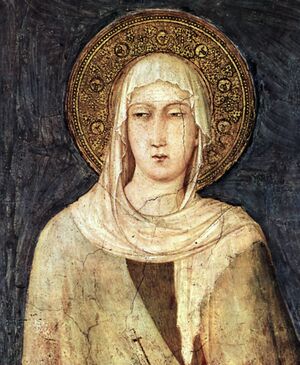Saint Clare

Saint Clare of Assisi (1194–1253) was one of the incarnations of Elizabeth Clare Prophet. She was the cofounder with Saint Francis of the Order of the Poor Ladies, or Poor Clares, as the Franciscan nuns came to be called.
Early life
Clare was born Chiara Scifi on July 16, 1194, at Assisi in Umbria, the eldest of five children. Her parents were of noble descent, and they lived in a palace in Assisi. Her mother was notably pious. While she was in prayer just before Clare was born, she heard a voice saying to her: “Fear not, Ortolana; thou shalt safely bring forth a light which shall enlighten the whole world clearly.” Clare received her name because of the last word of this prophecy.
In the year 1212, Saint Francis preached a series of sermons at the church of San Giorgio in Assisi. Clare, now eighteen, attended those sermons and wept. She secretly left her family and went to Francis, took her vows before him, and put herself under his direction. Her relatives found her and tried to persuade her to go home but it was no use. She and a small group of women who had chosen her life settled in a cottage next to the chapel of San Damiano. Thus the first community of Franciscan nuns was established.
The Poor Clares
Clare was one of the primary people who spread the Franciscan movement. The nuns practiced austerities unusual for women at that time. They slept on the ground, abstained from eating meat, went barefoot and spoke only when obliged to do so. Following Francis’ rule that they own no property, they received all their material necessities and sustenance from alms.
Because of her austerities, Clare was almost always sick and confined to her bed. Her illness continued for the last twenty-seven years of her life.

Devotion to the Eucharist
Saint Clare had a special devotion to the Holy Eucharist. She was inflamed with love for Jesus Christ and believed that there was no better practice to testify her gratitude than to adore several times a day the Sacred Heart of Jesus in the Most Blessed Sacrament.
As related in her biographies, her soul was filled with the sweetest delights and very special favors. So devoted was Saint Clare to the Sacred Heart in the Most Blessed Sacrament that her emblem became the monstrance, and in art she is frequently represented with a monstrance or a ciborium.
Clare’s special devotion to the Holy Eucharist saved her convent at San Damiano from a group of Saracens in the army of Frederick II who were on their way to plunder nearby Assisi c. 1240. As the soldiers scaled the convent walls, Clare rose from her sick bed and, according to one account, had the Blessed Sacrament set up in view of the enemy—prostrating herself before it and calmly praying aloud (other versions of the story state that Clare herself held up the Sacrament while facing the infidels). At the sight of this, the advancing soldiers were suddenly seized with terror and took flight.
Not long after, a larger group led by one of Frederick’s generals returned to attack the town. Clare and the nuns prayed fervently through the day and night that Assisi might be spared. At dawn, a furious storm broke over the army’s camp, scattering their tents and forcing them to flee in panic.
Legacy
Clare’s support of Saint Francis and his ministry was a large part of her mission. It was to Clare that Francis turned when in doubt and it was she who urged him to continue his ministry to the people rather than lead a life of contemplation.
One author writes:
Clare was not only constant in work, she was frequent in prayer. It is told that she once stayed three days in a trance, and there is no doubt that she tasted the supreme bliss of the Heavenly Vision that is the crown and glory of the religious life. There are many legends about these later years that tell of her as the ecstatic—as the contemplative.[1]
Clare died at the age of sixty. We can call to her causal body to invoke the momentum of her power of prayer in our life and to establish a personal relationship with Jesus.
See also
Sources
Holy Days Calendar, August 1993.
Elizabeth Clare Prophet, October 5, 1992.
Archangel Gabriel, Mysteries of the Holy Grail, endnotes.
- ↑ Saint Clare and Her Order: A Story of Seven Centuries.
